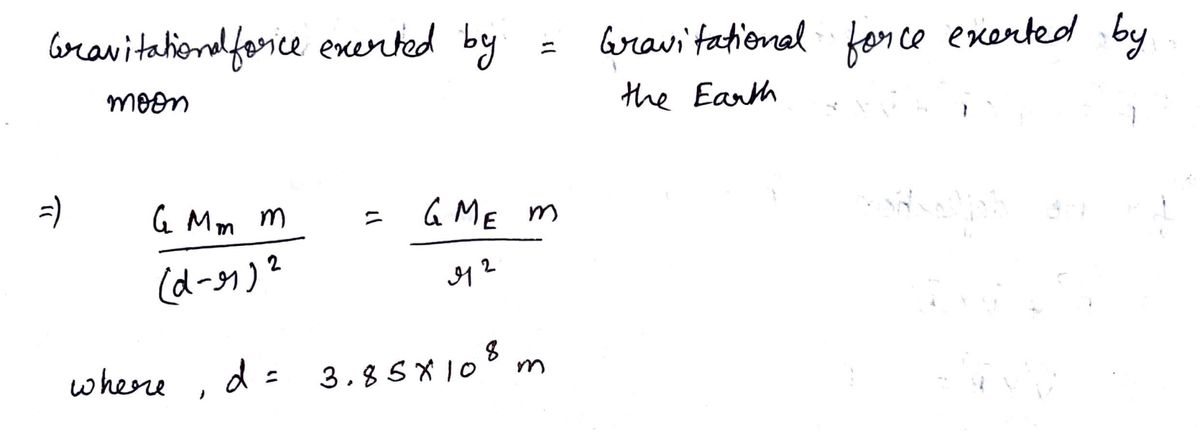A spacecraft is on a journey to the moon. At what point, as measured from the center of the earth, does the gravitational force exerted on the spacecraft by the earth balance that exerted by the moon? This point lies on a line between the centers of the earth and the moon. The distance between the earth and the moon is 3.85 x 108 m, and the mass of the earth is 81.4 times as great as that of the moon. Number i Units Bove
Gravitational force
In nature, every object is attracted by every other object. This phenomenon is called gravity. The force associated with gravity is called gravitational force. The gravitational force is the weakest force that exists in nature. The gravitational force is always attractive.
Acceleration Due to Gravity
In fundamental physics, gravity or gravitational force is the universal attractive force acting between all the matters that exist or exhibit. It is the weakest known force. Therefore no internal changes in an object occurs due to this force. On the other hand, it has control over the trajectories of bodies in the solar system and in the universe due to its vast scope and universal action. The free fall of objects on Earth and the motions of celestial bodies, according to Newton, are both determined by the same force. It was Newton who put forward that the moon is held by a strong attractive force exerted by the Earth which makes it revolve in a straight line. He was sure that this force is similar to the downward force which Earth exerts on all the objects on it.
![### Title: Determining the Balance Point of Gravitational Forces Between Earth and the Moon
**Problem Statement:**
A spacecraft is on a journey to the moon. At what point, as measured from the center of the Earth, does the gravitational force exerted on the spacecraft by the Earth balance that exerted by the Moon? This point lies on a line between the centers of the Earth and the Moon. The distance between the Earth and the Moon is \(3.85 \times 10^8 \, \text{m}\), and the mass of the Earth is 81.4 times as great as that of the Moon.
**Diagram Explanation:**
- The diagram shows the Earth and the Moon with a line connecting their centers.
- The spacecraft is positioned on this line.
- Arrows represent the gravitational forces (\(F_{\text{moon}}\) and \(F_{\text{earth}}\)) exerted by the Moon and the Earth on the spacecraft.
**Solution Steps:**
1. **Identify the Forces:**
- The gravitational force exerted by the Earth is \(F_{\text{earth}}\).
- The gravitational force exerted by the Moon is \(F_{\text{moon}}\).
2. **Calculate the Balance Point:**
- The balance point occurs where \(F_{\text{earth}} = F_{\text{moon}}\).
3. **Known Values:**
- Distance between Earth and Moon: \(3.85 \times 10^8 \, \text{m}\).
- Mass ratio: Earth’s mass is 81.4 times Moon’s mass.
4. **Equation Setup (Gravitational Force Formula):**
- Use the formula for gravitational force:
\[
F = \frac{G \cdot m_1 \cdot m_2}{r^2}
\]
- Set forces equal to find the balance point.
**Interactive Components:**
- Input fields for numeric answer and units.
- Option to save the answer for later.
- Hints or tools available through an eTextbook and Media link.
**Submission:**
- Attempt 0 of 3 used.
- Submit Answer button for entering the solution.
This educational problem helps reinforce concepts related to gravitational forces and celestial mechanics.](/v2/_next/image?url=https%3A%2F%2Fcontent.bartleby.com%2Fqna-images%2Fquestion%2Fd1ba70b0-0b8e-40ed-8a60-2641276941d0%2Fbefe43ca-54ce-4505-b883-7b1f1a0d5b8f%2Fslt7wy_processed.jpeg&w=3840&q=75)

Step by step
Solved in 2 steps with 2 images









